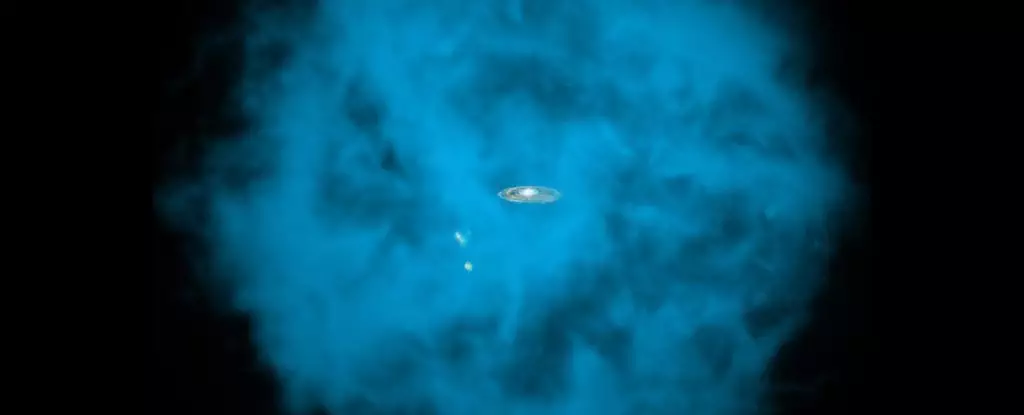In a breakthrough that shines light on one of astronomy’s most enduring mysteries, researchers have finally determined where the missing half of the Universe’s visible matter has been lurking. For decades, scientists have grappled with the conundrum of baryonic matter—the ordinary matter that composes stars, planets, and galaxies—only to find significant portions of it missing. This latest investigation reveals that vast clouds of ionized hydrogen have been hiding in the intergalactic space, far beyond the reach of our previous observational efforts. This discovery not only deepens our understanding of the cosmos but also reconfigures our approach to galaxy formation and evolution.
The New Methodology Behind the Discovery
The quest to locate this elusive matter involved an international team of astronomers who developed a novel technique to peer into the darkness of the Universe. Traditionally, hydrogen exists in such diffuse forms that it eludes detection through conventional means. However, by utilizing changes in the cosmic microwave background radiation—essentially the afterglow of the Big Bang—researchers devised a method known as the kinematic Sunyaev-Zel’dovich effect. As light from the cosmic microwave background travels through clouds of ionized hydrogen, it undergoes subtle dimming or brightening. By stacking multiple observations, the team effectively amplified these faint signals, revealing the extensive halos of hydrogen encircling not just our Milky Way, but also millions of other galaxies.
This innovative approach allows for a much deeper inquiry into the larger structure of the Universe, and scientists are now coming to realize that these halos might extend even further than initially studied. The notion that these clouds can be detected and mapped opens fresh avenues for future astronomical exploration.
Hydrogen: The Universes’ Most Abundant Substance
Comprising approximately 90% of the Universe’s atoms and a staggering 73% of its mass, hydrogen’s significance cannot be overstated. Yet, a glaring deficit in our understanding persisted: where had all the Universe’s hydrogen gone? The analysis indicates that over half of the baryonic hydrogen has been overlooked in prior studies. It’s remarkable yet perplexing that seemingly ordinary hydrogen could go undetected amid an otherwise well-mapped cosmic landscape.
This revelation not only alters our comprehension of the baryonic content of the Universe but also highlights the importance of interdisciplinary approaches in scientific investigations. The blending of cosmology, advanced imaging techniques, and computational modeling has led to ground-breaking understandings—that perhaps we were looking in the wrong places all along.
Implications of the New Findings
This groundbreaking discovery poses numerous questions, particularly regarding the interrelation between individual galaxies and their hydrogen halos. These halos are not passive; they are influenced by external forces such as incoming gas and the active cycles of supermassive black holes located at the centers of galaxies. The findings dovetail with ongoing research into black hole behavior, revealing that these colossal entities may experience “on” and “off” states, dynamically impacting their halos.
When a black hole feeds rapidly, it launches jets of energy and matter that traverse vast distances, creating powerful winds that shape the surrounding environment. This interplay leads to a delicate balance between star formation and galactic evolution, emphasizing the fundamental role black holes play in shaping cosmic structures.
Linking Hydrogen to Dark Matter
Further complicating the narrative is the relationship between baryonic matter and dark matter. Some of the lost hydrogen may be interwoven into the fabric of dark matter filaments that comprise the cosmic web—all part of a vast network connecting galaxies across great distances. The challenge now lies in integratively understanding how these two realms interact, as clarifying their relationship will enhance our models of galaxy formation and ultimately reshape our understanding of the Universe’s architecture.
The research provides a new framework for understanding the spatial distribution of hydrogen, making it a focal point for future studies in cosmology. The implications are indeed vast, as unearthing this missing hydrogen not only enriches our understanding of galaxy evolution but also reshapes our fundamental views on baryonic and dark matter.
The Outlook for Future Research
As our observational techniques become increasingly sophisticated, the potential for further discoveries remains boundless. This shift in focus to the cosmic microwave background and its interaction with intergalactic hydrogen could lead to a cascade of new findings, perhaps unveiling even more hidden aspects of our Universe. Research into these clouds offers an exciting and promising direction for scientists eager to decode the secrets of the cosmos.
By vigorously pursuing these intriguing connections, astronomers can hope to finally stitch together a more coherent picture of our Universe—one that acknowledges the complex relationships between visible and dark matter, and how they collectively contribute to the grandeur of the cosmic tapestry. The scientific community is on the cusp of an exhilarating new era of discovery, where understanding is not just additive, but transformative.

